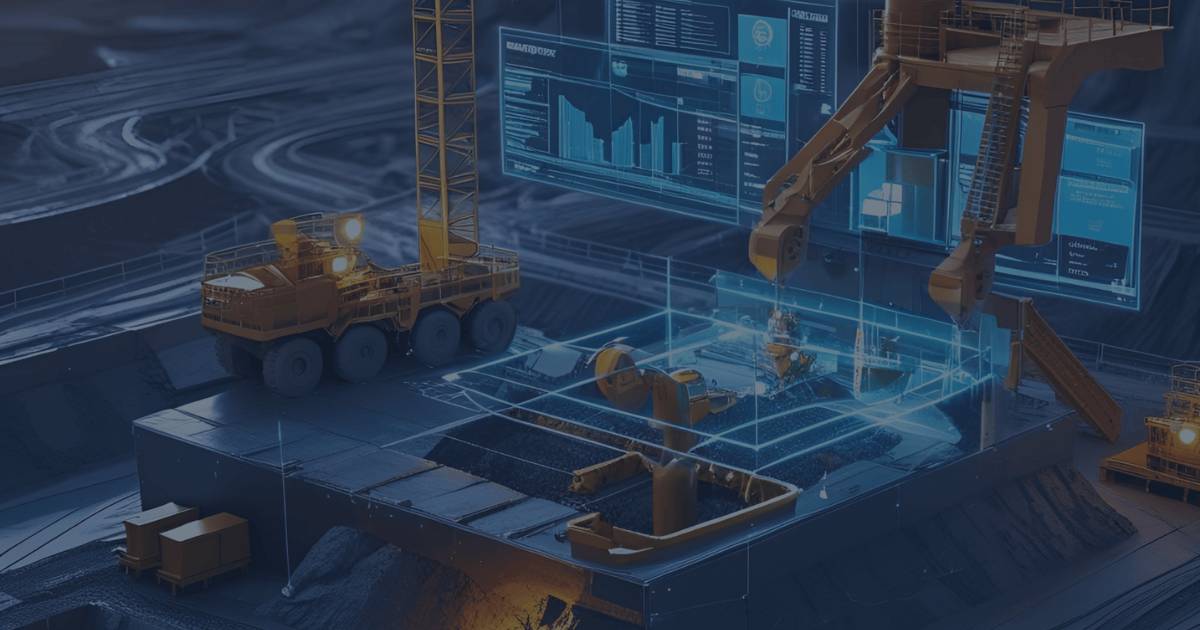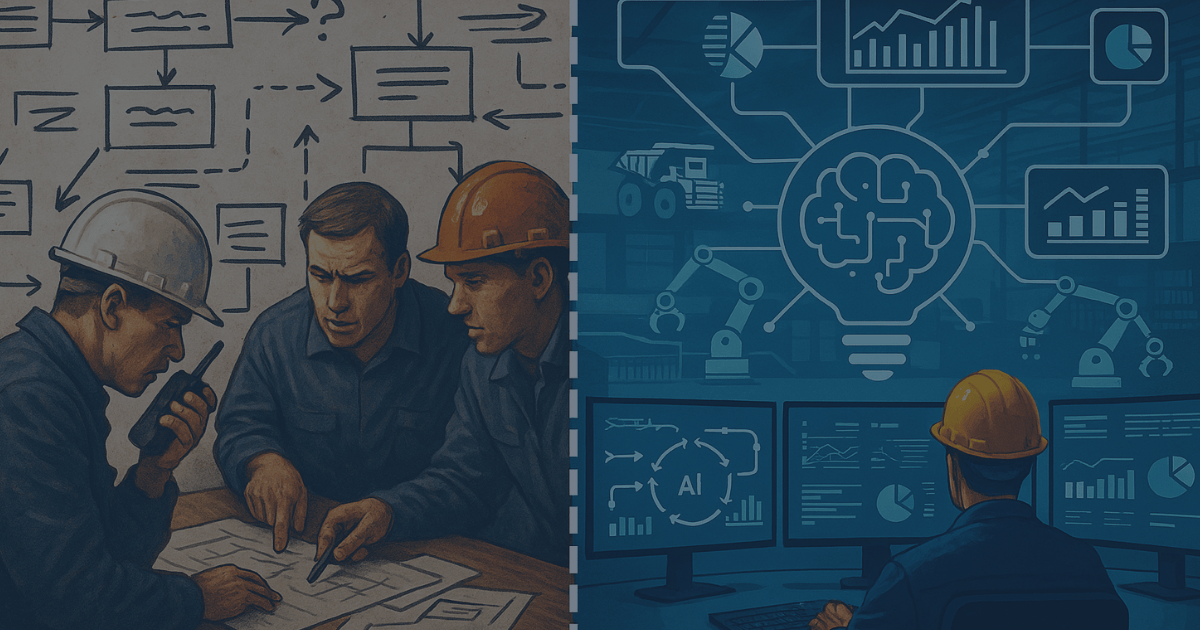
Why Coordination Is the Real Bottleneck in Industry
Why real gains in mining and manufacturing won’t come from machines, but from how we orchestrate them.
- NTWIST
The Illusion of Capacity
If you walk onto any mine site or plant floor in 2025, odds are you’ll hear the same refrain: “We need more throughput.” For decades, this phrase has justified capital expenditure on new equipment, control systems, automation platforms, and IoT infrastructure. But as we step further into the age of AI-powered operations, one uncomfortable truth is becoming clear:
We don’t have a capacity problem. We have a coordination problem.
Despite massive investment in digitization, industrial performance still lags. In mining, average equipment utilization remains below 65% at many sites - even those considered digitally mature (PwC, 2024). In manufacturing, only 24% of companies report real-time visibility across production and logistics workflows, despite widespread adoption of ERP and MES systems (BCG, 2025). Why?
Because visibility without orchestration is noise.
Data, Disconnected
Today’s mines and factories are capturing more data than ever before - haul cycles, shift performance, weather impacts, operator input variance, even maintenance logs. But most of that data sits in silos: SCADA, PLCs, fleet systems, third-party dashboards, spreadsheets. The result is a kind of digital paralysis. Teams are inundated with information, but still make decisions based on gut feel or fire-drill triage.
We’ve seen this firsthand. In one of NTWIST’s recent site audits for a gold mining operation in North America, the control room was running four screens with mill feed forecasts, but dispatchers were still making manual override calls based on verbal updates from shovel operators. The tech existed - but it wasn’t integrated in a way that changed behavior. Equipment wasn't the constraint. Human coordination was.
A similar pattern is playing out in batch manufacturing. Our nScheduler implementation at a food production facility revealed that even with a state-of-the-art MES, downtime events were often mishandled due to siloed information. The system could track stoppages - but it couldn’t reprioritize the production queue based on shifting constraints, raw material arrival changes, or rush orders. Operators were left making decisions in isolation.
The Fallacy of Isolated Optimization
There’s a long-standing industrial myth that you can optimize performance unit by unit: “Let’s get the truck cycle time down.” “Let’s hit nameplate on the mill.” “Let’s reduce changeover time on Line 4.”
But true system efficiency doesn’t come from local optimization. It comes from cross-functional coordination - aligning every asset, team, and constraint around a dynamic, shared understanding of what matters right now.
This insight is something forward-looking mining leaders are beginning to act on. For many, grader dispatch isn’t just a task allocation challenge - it’s the first node in a much larger orchestration problem. The ambition isn’t limited to improving assignments. It’s about transforming dispatch into an intelligent, interconnected layer of the operation - one that can inform downstream blending, support traceability, and feed reconciliation efforts. That’s what makes these solutions valuable - not just operationally, but strategically.
At several end-of-life mines, we’ve seen leaders explore how better coordination - not new capital investment - can unlock unused capacity in downstream processing. It’s not about what equipment you have. It’s about how you orchestrate it.
Coordination at Scale Requires Intelligence
You can’t coordinate an operation by adding more dashboards. More meetings. More rules.
You coordinate by embedding intelligence into the system itself.
That means systems that:
- Understand current constraints in real time
- Forecast downstream impacts of today’s decisions
- Dynamically adjust recommendations as reality shifts
- Align human teams with automated actions across the value chain
That’s what we build at NTWIST. And it’s what modern industrial performance demands.
Intelligence Without Execution Is a Dead End
One of the most dangerous assumptions in industrial digitization is that visibility equals control. Companies invest in sensors, dashboards, and data platforms expecting transformation - yet their KPIs barely move. Why?
Because knowing something and acting on it are not the same thing.
A 2025 study by Boston Consulting Group found that 68% of industrial firms implementing digital platforms saw “limited or no measurable operational improvement” after year one. The primary cited issue? Lack of integration between data insights and execution layers (BCG, 2025).
This disconnect is especially visible in time-sensitive decisions - like shift planning, rerouting material, or responding to equipment constraints. When teams don’t have shared logic around how to prioritize, every delay turns into a firefight.
From Priority Lists to AI-Driven Decision Flows
Closing that gap requires more than AI models that predict outcomes. It requires AI systems that rank, recommend, and rebalance priorities in real time.
In our deployment of nScheduler within a mixed-production manufacturing site, we observed a 25% gain in capacity - not because machines ran faster, but because orders, materials, and resources were dynamically reshuffled based on real-time constraints. The schedule didn’t just update. It adapted.
Why Mines Struggle With Real-Time Coordination
Mining presents unique challenges: long feedback loops, unpredictable material variability, and non-linear process dependencies. It’s not just about reacting fast. It’s about anticipating complexity and coordinating across systems that were never designed to speak to one another.
Forward-looking operations are starting to pursue this vision - treating systems like dispatch, blending, and load management not as separate tools but as connected nodes in a unified decision-support framework.
The Manufacturing Parallel
If mining is rugged and non-linear, manufacturing often deals with high frequency, high variability production environments - especially in batch or discrete operations.
A 2025 report from Frost & Sullivan notes that while 82% of mid-sized manufacturers have digitized some part of their planning workflows, only 19% are using real-time, AI-powered scheduling (Frost & Sullivan, 2025).
This isn’t about digitization. It’s about synchronization.
Point Solutions Can’t Coordinate a System
One of the most common missteps we see across industrial sectors is the adoption of isolated, high-promise tools. A dashboard for asset health. A standalone app for stockpile tracking. A new scheduling module inside the ERP.
Across conversations with operational leaders, a consistent message has emerged: “It’s not that our tools don’t work - it’s that they don’t work together.” When decisions around dispatch, planning, and quality operate on separate logic trees, the result isn’t agility - it’s conflict.
This is why NTWIST refuses to build “just another tool.” Every module in our stack - from nGeoMet-AI to nScheduler - is designed to function as part of a larger, unified decision layer.
Future-Proofing Coordination
Coordination isn’t a one-time project. It’s a capability. And building it requires more than software.
- Cultural alignment: Are teams incentivized to work across silos?
- Process realism: Are models built around what actually happens at 2:00 AM on a Sunday shift?
- Strategic intent: Is the end goal faster reports - or better decisions?
The most advanced companies treat coordination as a competitive advantage. They anchor AI into operational rhythms. They audit not just system performance - but decision latency. They don’t just measure uptime. They measure how fast the organization responds when something goes down.
Conclusion: Orchestrate or Obsolete
The industrial sector isn’t short on technology. It’s short on alignment. The equipment isn’t the bottleneck anymore. Coordination is.
And that’s exactly where NTWIST is focused: building systems that don't just see - but act. That don't just track - but synchronize. That don't just predict - but prioritize - across every moving part in your operation.
Coordination is the constraint. We’ve already solved for it.
References
Boston Consulting Group. (2025). From Potential to Profit: Closing the AI Impact Gap. Retrieved from https://www.bcg.com/publications/2025/closing-the-ai-impact-gap
PwC. (2024). Mine 2024: Preparing for Impact. Retrieved from https://www.pwc.com/gx/en/industries/energy-utilities-resources/publications/mine.html
Frost & Sullivan. (2025). Hyperautomation: AI's Role in Transforming Business Processes. Retrieved from https://www.frost.com/events/innovation/hyperautomation-ais-role-in-transforming-business-processes/
Boston Consulting Group. (2024). AI-Powered KPIs Measure Success Better. They Also Redefine It. Retrieved from https://www.bcg.com/publications/2024/how-ai-powered-kpis-measure-success-better


